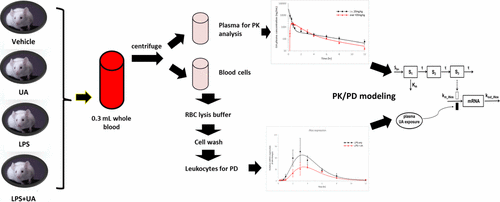当前位置:
X-MOL 学术
›
Mol. Pharmaceutics
›
论文详情
Our official English website, www.x-mol.net, welcomes your
feedback! (Note: you will need to create a separate account there.)
Pharmacokinetics and Pharmacodynamics of the Triterpenoid Ursolic Acid in Regulating the Antioxidant, Anti-inflammatory, and Epigenetic Gene Responses in Rat Leukocytes
Molecular Pharmaceutics ( IF 4.5 ) Pub Date : 2017-10-25 00:00:00 , DOI: 10.1021/acs.molpharmaceut.7b00469 Chengyue Zhang 1, 2 , Chao Wang 1 , Wenji Li 1 , Renyi Wu 1 , Yue Guo 1, 2 , David Cheng 1, 2 , Yuqing Yang 1, 2 , Ioannis P. Androulakis 3 , Ah-Ng Kong 1, 2
Molecular Pharmaceutics ( IF 4.5 ) Pub Date : 2017-10-25 00:00:00 , DOI: 10.1021/acs.molpharmaceut.7b00469 Chengyue Zhang 1, 2 , Chao Wang 1 , Wenji Li 1 , Renyi Wu 1 , Yue Guo 1, 2 , David Cheng 1, 2 , Yuqing Yang 1, 2 , Ioannis P. Androulakis 3 , Ah-Ng Kong 1, 2
Affiliation

|
The triterpenoid ursolic acid (UA) has been proposed as a potential cancer chemopreventive agent in many preclinical and clinical studies. In the present work, we aimed to characterize the pharmacokinetics (PK) of UA and to quantitatively assess the antioxidative and anti-inflammatory effects of UA, which are potentially linked to its chemopreventive efficacy. UA was administered intravenously (i.v., 20 mg/kg) or by oral gavage (100 mg/kg) to male Sprague–Dawley rats, and blood samples were collected at a series of designated time points. The plasma concentration of UA was determined using a validated liquid chromatography–mass spectrometry (LC-MS) approach. A biexponential decline in the UA plasma concentration was observed after i.v. dosing and was fitted to a two-compartmental model. The expression levels of phase II drug metabolism (DM)/antioxidant genes and the inflammatory iNos gene in corresponding treatment arms were measured using qPCR as a pharmacodynamic (PD) marker. The expression of phase II DM/antioxidant genes increased and peaked approximately 3 h after 20 mg/kg UA treatment. In a lipopolysaccharide (LPS)-induced acute inflammation model, UA inhibited LPS-stimulated iNos expression and that of the epigenetic markers the DNA methyltransferases (DNMTs) and histone deacetylases (HDACs) in leukocytes. A PK–PD model using Jusko’s indirect response model (IDR) with transition compartments (TC) was established to describe the time delay and magnitude of the gene expression elicited by UA. The PK–PD model provided reasonable fitting linking the plasma concentration of UA simultaneously with the PD response based on leukocyte mRNA expression. Overall, our results indicate that UA is effective at inducing various phase II DM/antioxidant genes and inhibiting pro-inflammatory genes in vivo. This PK–PD modeling approach may provide a conceptual framework for the future clinical evaluation of dietary chemopreventive agents in humans.
中文翻译:

三萜类乌索酸在调节大鼠白细胞抗氧化,抗炎和表观遗传基因应答中的药代动力学和药效学
在许多临床前和临床研究中,三萜类熊果酸(UA)已被提议作为潜在的癌症化学预防剂。在目前的工作中,我们旨在表征UA的药代动力学(PK),并定量评估UA的抗氧化和抗炎作用,这些作用可能与其化学预防功效有关。对雄性Sprague-Dawley大鼠静脉内(iv,20 mg / kg)或口服强饲法(100 mg / kg)施用UA,并在一系列指定的时间点采集血样。UA的血浆浓度是使用经过验证的液相色谱-质谱(LC-MS)方法确定的。静脉给药后观察到UA血浆浓度双指数下降,并拟合为两室模型。使用qPCR作为药效学(PD)标记物测量了相应治疗组中II期药物代谢(DM)/抗氧化剂基因和炎性iNos基因的表达水平。II DM /抗氧化剂基因的表达在20 mg / kg UA处理后约3小时增加并达到峰值。在脂多糖(LPS)诱导的急性炎症模型中,UA抑制LPS刺激的iNos表达以及白细胞中DNA甲基转移酶(DNMTs)和组蛋白脱乙酰基酶(HDACs)的表观遗传标记。建立了使用Jusko的间接反应模型(IDR)和过渡区(TC)的PK-PD模型,以描述UA引起的基因表达的时间延迟和幅度。PK-PD模型提供了合理的拟合,可以将UA的血浆浓度与基于白细胞mRNA表达的PD反应同时联系起来。总体而言,我们的结果表明,UA可有效诱导各种II期DM /抗氧化基因并抑制促炎基因体内。这种PK-PD建模方法可以为人类饮食化学预防剂的未来临床评估提供概念框架。
更新日期:2017-10-26
中文翻译:

三萜类乌索酸在调节大鼠白细胞抗氧化,抗炎和表观遗传基因应答中的药代动力学和药效学
在许多临床前和临床研究中,三萜类熊果酸(UA)已被提议作为潜在的癌症化学预防剂。在目前的工作中,我们旨在表征UA的药代动力学(PK),并定量评估UA的抗氧化和抗炎作用,这些作用可能与其化学预防功效有关。对雄性Sprague-Dawley大鼠静脉内(iv,20 mg / kg)或口服强饲法(100 mg / kg)施用UA,并在一系列指定的时间点采集血样。UA的血浆浓度是使用经过验证的液相色谱-质谱(LC-MS)方法确定的。静脉给药后观察到UA血浆浓度双指数下降,并拟合为两室模型。使用qPCR作为药效学(PD)标记物测量了相应治疗组中II期药物代谢(DM)/抗氧化剂基因和炎性iNos基因的表达水平。II DM /抗氧化剂基因的表达在20 mg / kg UA处理后约3小时增加并达到峰值。在脂多糖(LPS)诱导的急性炎症模型中,UA抑制LPS刺激的iNos表达以及白细胞中DNA甲基转移酶(DNMTs)和组蛋白脱乙酰基酶(HDACs)的表观遗传标记。建立了使用Jusko的间接反应模型(IDR)和过渡区(TC)的PK-PD模型,以描述UA引起的基因表达的时间延迟和幅度。PK-PD模型提供了合理的拟合,可以将UA的血浆浓度与基于白细胞mRNA表达的PD反应同时联系起来。总体而言,我们的结果表明,UA可有效诱导各种II期DM /抗氧化基因并抑制促炎基因体内。这种PK-PD建模方法可以为人类饮食化学预防剂的未来临床评估提供概念框架。











































 京公网安备 11010802027423号
京公网安备 11010802027423号